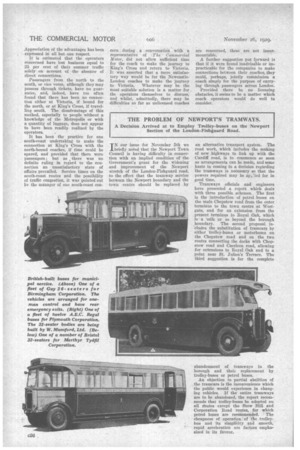THE PROBLEM OF NEWPORT'S TRAMWAYS.
Page 74

Page 75

If you've noticed an error in this article please click here to report it so we can fix it.
A Decision Arrived at to Employ Trolley-buses on the Newport Section of the London-Fishguard Road.
IN our issue for November 5th we briefly noted that the Newport Town Council is haying difficulty in Connection with an implied condition of the Government's grant for the widening and improvement of the Newport stretch of the London-Fishguard road, to the effect that the tramway service between the Newport boundary and the town centre should be replaced by
an alternative transport system. The road work, which includes the making of new highways to link up with the Cardiff road, is to commence so soon as arrangements can be made, and some haste in coming to a decision regarding The tramways is necessary so that the powers required may be api,]ied for in good time.
Tramways officials and engineers have presented a report which deals with three possible schemes. The first is the introduction of petrol buses on the main Chepstow road from the outer terminus to the town centre at Westgate, and for an extension from the present terminus to Royal Oak, which is a -mile or so beyond the borough boundary. The second proposal in-chides the substitution of tramcars by either trolley-buses or motorbuses on the Chepstow road and on the two routes connecting the docks with Chepstow road and Caerleon road, allowing for extensions to Royal Oak and to a point near St. Julien's Terrace. The third suggestion is for the complete
abandonment of tramways in the borough and theie replacement by trolley-buses or petrol buses.
An objection to partial abolition of the tramcars is the inconvenience which the public would experience in changing vehicles. If the entire tramways are to he abandoned, the report recommends that trolley-buses be adopted on all notes except the Stow Hill and Corporation Road routes, for which petrol buses are recommended. The cheapness of operation of the trolleybus and its simplicity ana smooth, rapid acceleration are factors emphasized in its favour.
The outstanding-loans debt on the tramways system, namely, £173,507, less certain assets, will have to be repaid in 10 years if complete substitution be effected. Tracks and overhead lines, except in a few places, are in good condition, and it may be considered wise to obtain a few more years of use out of the tramcars before dispensing with them.
Assuming that the third proposal of complete tramways abandonment be carried into effect, the estimated annual result would be as follows :— Allowing for sundries the estimated annual loss would be £11,388, whereas the expected loss on the tramways system for the current year is £4,289.
So far as the Chepstow road route is concerned, it has been decided to install a trolley-bus system, 12 vehicles being required. It is expected that there will be a net annual loss of £1,663 on this route when the repayment of loan charges is. deducted from the anticipated working profit of £3,000. Incidentally, the Chepstow road route is the most profitable of the Newport tram services.
The opinion is expressed that the entire Newport tramways system will ultimately be abandoned in favour of trolley-buses.




























































































































